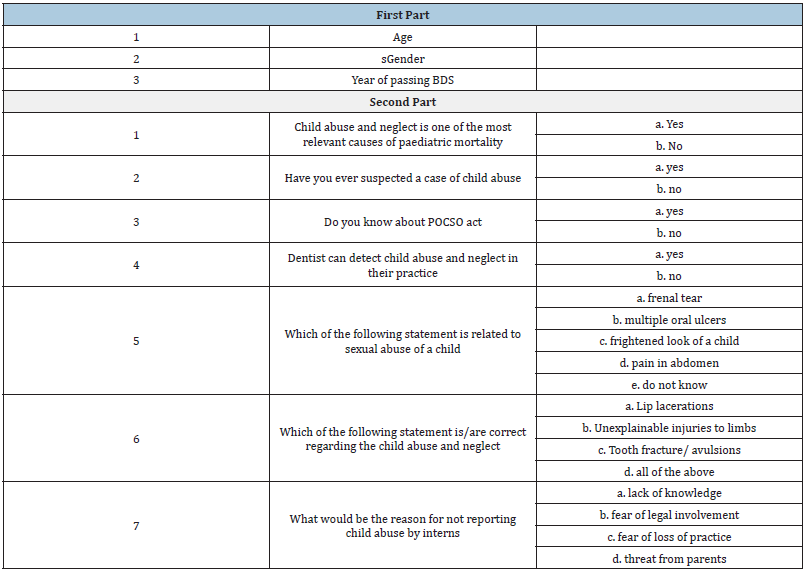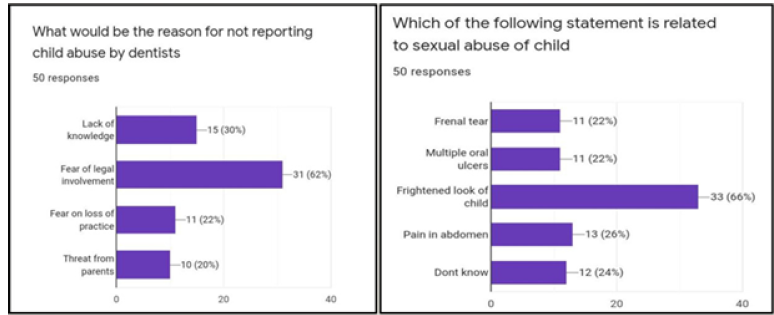- Submissions

Full Text
Novel Research in Sciences
Knowledge, Attitude and Practice on Child Abuse and Neglect among BDS Interns of a Tertiary Care Hospital in India- A cross Sectional Questionnaire Study
Aravindhan Arumugam1*, Dipika Yadav2, Afroz Alam Ansari3, Jyoti Solanki2, Bhawana Kumari2 and Simran Shivhare2
1Senior Resident, Department of Pediatric & Preventive Dentistry, King George’s Medical University, UP, Lucknow
2Junior Resident, Department of Pediatric & Preventive Dentistry, King George’s Medical University, UP, Lucknow
3Professor, Department of Pediatric & Preventive Dentistry, King George’s Medical University, UP, Lucknow
*Corresponding author:Aravindhan Arumugam, Senior Resident, Department of Pediatric & Preventive Dentistry, King George’s Medical University, UP, Lucknow
Submission: January 05, 2023;Published: January 26, 2023
.jpg)
Volume13 Issue2January , 2023
Abstract
Introduction: Health Care Professionals (HCP) are the first one wchildagnose the child abuse and neglect
(CAN) and it is their moral responsibility to report child abuse. But there are many obstacles in the
reporting of CAN by a dentist.
Objectives: This study was conducted to analyze the knowledge, attitude and practice on CAN among
undergraduate dental (BDS) interns in a tertiary care hospital in India.
Method: A structured, validated online questionnaire link was mailed to 50 BDS interns for their
response. The data was transferred to an excel sheet and subjected to descriptive statistical analysis.
Result: overall 100% response rate was observed from the participants. The majority of the interns (80%,
n=40) agreed that dentist can diagnose and report the CAN but the knowledge regarding the legal act
(66%, n=33) is less among the interns. Lack of knowledge regarding child abuse diagnosis (30%, n=15)
and fear of legal involvement (62%, n=31) are the common reasons for not reporting CAN by interns.
Conclusion: The present study found that the knowledge regarding the CAN among undergraduate dental interns was adequate but still there are lacunae in reporting the cases by interns. Elaborative curriculum with the proper teaching of child abuse and its ethical and legal aspects in the undergraduate level is the need of the hour.
Keywords: Child abuse and neglect; Dentists role; Sexual abuse
Introduction
Child abuse is any form of physical, emotional, or sexual ill-treatment, or neglect, resulting in actual or potential harm to the child’s health and development [1,2]. Many studies have confirmed the detrimental effects of adverse childhood experiences, including severe impairments to social development, learning, and physical and emotional health [3,4]. It is a growing worldwide problem with no social, ethnic, or racial bounds. The five main subtypes of Child Abuse and Neglect (CAN) are physical abuse, emotional maltreatment, neglect, sexual abuse and witnessing family violence [5]. Globally in 2014, 1 billion children aged 217 years experienced physical, sexual, emotional or multiple types of violence [6]. A quarter of all the adults report having been physically abused as children. One in five women and one in 13 men report having been sexually abused as a child. Every year, there are an estimated 41,000 homicide deaths in children under 15 years of age [7]. According to a study in India, Health Care Professionals (HCP) have a poor attitude and knowledge of child abuse and neglect under the code of conduct and law, and there is insufficient available information regarding this [8]. To the best of our knowledge, there is no study on the Knowledge, Attitude, and Practice (KAP) of BDS interns regarding child abuse in India. This study is being carried out to determine the awareness and knowledge of child abuse and its management among undergraduate dental interns in a government tertiary care hospital.
Material and Methods
The study was conducted in a centenary old medical/dental college with tertiary care hospital, Lucknow city, India. After obtaining consent from the participants, the pre-tested and validated questionnaires (online questionnaire link, Google FormsTM, Google LLC, U.S.A) was mailed to all participants. The study was anonymous, voluntary and all of the respondents signed an informed consent. The average time needed to fill out the questionnaire was about 10min. The questionnaire consisted of 10 questions divided into two parts (Table 1). In the first part of the questionnaire consists of age, gender and year of BDS completion. The second part of the questionnaire referred to the knowledge, attitude and practice of the respondent on the topic of CAN. The responses obtained were entered into an excel sheet and descriptive statistics was used to obtain the results.
Table 1:Questionnaire of the study.

Result
A total of 50 BDS interns have attended the survey and a response rate of 100% was observed. There were 60% female (n=30) and 40% male (n=20) interns participated in the survey. Only 80% (n=40) of the participants agreed that the dentist can diagnose and report CAN in their practice. 72% (n=36) of the respondents were aware regarding child abuse, 66% (n=33) of the respondents were aware of POCSO (Prevention of Children from Sexual Offences) act (Figure 1). 90% (n=45) of the respondents were not suspected of child abuse during their clinical posting. The majority of the participants (86%, n=43) were aware that all the unexplainable injuries to limb, tooth fracture/ avulsions and lip lacerations are suggestive of child abuse (Figure 2). Lack of knowledge regarding child abuse diagnosis (30%, n=15) and fear of legal involvement (62%, n=31) are the main reasons for not reporting child abuse by interns. 24% interns (n=12) did not even have basic awareness about the sexual abuse of children (Figure 3).
Figure 1:

Figure 2:

Figure 3:

Discussion
Childhood is a joyful and memorable period of life. Bad experiences in childhood lead to psychological trauma in the life of the affected persons, which could be life lasting. Child abuse and neglect is a developing challenge in modern society and it needs to be eradicated by means of strict laws. Though we have robust acts and amendments, there are hurdles in the society for reporting of CAN. The awareness among the HCPs plays a vital role in this as they are the frontline responders of child abuse and neglect followed by police, lawyers and child welfare organisations. According to a recent study, 18.8% of abused children had signs of dental trauma and 30% of children had laceration and soft tissue mucosal injuries [9]. This reveals the importance of dentists in the diagnosis of CAN. The present study analysed the knowledge, attitude and practice of CAN among BDS interns in a tertiary care hospital of Lucknow city, India.
The majority of the interns (80%) are aware that dentists are one of the frontline respondents and they can diagnose and report child abuse in their career. But only a few (10%) suspected CAN in their training period. This could be due to hiding the cause of injury by parents/caregivers as it affects their family reputation in society. But it is the moral responsibility of the dentist to ask the child and parents separately about the cause and nature of the injury. It may give possible explanation to the injury and give suspicion of CAN. TEN 4-FACESp guidelines suggest child abuse if bruises or laceration present in torso, ear, neck, frenum, angle of mouth, cheeks, eyelids and subconjuctivae of children less than 5 years old [10]. But we suggest always suspect a child abuse as a rule of thumb when you examine a child with multiple dentofacial injuries regardless of age.
It was revealed that there was lack of proper knowledge among interns (34% interns were unaware) about the POCSO act and only 76% interns have basic symptoms and signs of sexual abuse in children. But majority of the interns (86%) are well aware about the physical abuse in children. Fear of legal involvement (62%) is the main reason put forth by interns for not reporting CAN. Other reasons include fear of loss/impact on practice and lack of proper knowledge about the diagnosis by very few participants. This is high time to give training to dental interns about the diagnosis and reporting of CAN in an effective manner. And also, the undergraduate dental curriculum should be updated accordingly.
Conclusion
The present study found that the knowledge regarding child abuse and neglect among undergraduate dental interns was adequate, but still there are lacunae in reporting the cases by interns. Elaborative curriculum with the proper teaching of child abuse and its ethical and legal aspects in the undergraduate level is the need of the hour.
References
- Leeb RT, Lewis T, Zolotor AJ (2011) A review of physical and mental health consequences of child abuse and neglect and implications for practice. Am J Lifestyle Med 5(5): 454-468.
- World Health Organization (1999) Report of the consultation on child abuse prevention. Violence and Injury Prevention Team & Global Forum for Health Research, Geneva, Switzerland.
- Petruccelli K, Davis J, Berman T (2019) Adverse childhood experiences and associated health outcomes: A systematic review and meta-analysis. Child Abuse Negl 97: 104127.
- Afifi TO, MacMillan HL, Boyle M, Cheung K, Taillieu T, et al. (2016) Child abuse and physical health in adulthood. Health Rep 27(3): 10-18.
- (2014) Australian institute of family studies. Effects of child abuse and neglect for adult survivors.
- (2018) World Health Organization Media Centre Fact Sheet. Violence Against Children.
- (2016) World Health Organization Media Centre Fact Sheet N° Child Maltreatment.
- Kirankumar SV, Noorani H, Shivaprakash PK, Sinha S (2011) Medical professional perception, attitude, knowledge, and experience about child abuse and neglect in Bagalkot district of north Karnataka: A survey report. J Indian Soc Pedod Prev Dent 29(3): 193-197.
- Barbi W, Sonawane RS, Singh P, Kumar S, Kumar BR, et al. (2021) Evaluation of the orofacial features in the victims of abuse and neglect of 5-16-year-old age children. J Pharm Bioallied Sci 13(Suppl 2): S1705-S1708.
- Pierce MC, Kaczor K, Lorenz DJ, Bertocci G, Fingarson AK, et al. (2021) Validation of a clinical decision rule to predict abuse in young children based on bruising characteristics. JAMA Netw Open 4(4): e215832.
© 2023 Aravindhan Arumugam. This is an open access article distributed under the terms of the Creative Commons Attribution License , which permits unrestricted use, distribution, and build upon your work non-commercially.
 a Creative Commons Attribution 4.0 International License. Based on a work at www.crimsonpublishers.com.
Best viewed in
a Creative Commons Attribution 4.0 International License. Based on a work at www.crimsonpublishers.com.
Best viewed in 







.jpg)






























 Editorial Board Registrations
Editorial Board Registrations Submit your Article
Submit your Article Refer a Friend
Refer a Friend Advertise With Us
Advertise With Us
.jpg)






.jpg)














.bmp)
.jpg)
.png)
.jpg)










.jpg)






.png)

.png)



.png)






